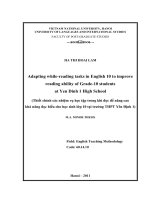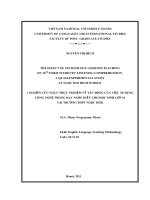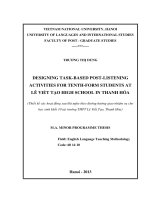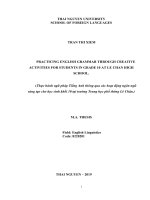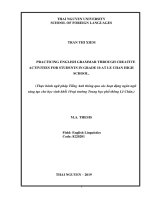Thiết kế các hoạt động sau khi nghe theo đường hướng giao nhiệm vụ cho học sinh khối 10 tại trường THPT Lê Viết Tạo, Thanh Hóa
Bạn đang xem bản rút gọn của tài liệu. Xem và tải ngay bản đầy đủ của tài liệu tại đây (736.9 KB, 70 trang )
VIETNAM NATIONAL UNIVERSITY, HANOI
UNIVERSITY OF LANGUAGES AND INTERNATIONAL STUDIES
FACULTY OF POST - GRADUATE STUDIES
***
TRƯƠNG THỊ DUNG
DESIGNING TASK-BASED POST-LISTENING
ACTIVITIES FOR TENTH-FORM STUDENTS AT
LÊ VIẾT TẠO HIGH SCHOOL IN THANH HÓA
(Thiết kế các hoạt động sau khi nghe theo đường hướng giao nhiệm vụ cho
học sinh khối 10 tại trường THPT Lê Viết Tạo, Thanh Hóa)
M.A. MINOR PROGRAMME THESIS
Field: English Language Teaching Methodology
Code: 60 14 10
Hanoi - 2013
VIETNAM NATIONAL UNIVERSITY, HANOI
UNIVERSITY OF LANGUAGES & INTERNATIONAL STUDIES
FACULTY OF POST- GRADUATE STUDIES
***
TRƯƠNG THỊ DUNG
DESIGNING TASK-BASED POST-LISTENING
ACTIVITIES FOR TENTH-FORM STUDENTS AT
LÊ VIẾT TẠO HIGH SCHOOL IN THANH HÓA
(Thiết kế các hoạt động Sau khi nghe theo đường hướng giao nhiệm vụ cho
học sinh khối 10 tại trường THPT Lê Viết Tạo, Thanh Hóa)
M.A. MINOR PROGRAMME THESIS
Field: English Language Teaching Methodology
Code: 60 14 10
Supervisor: Nguyê
̃
n Huy Kỷ, Ph.D
Hanoi – 2013
iv
LIST OF ABBREVIATIONS
CLT: Communicative Language Teaching
EFL: English as a Foreign Language
SLA: Second Language Acquisition
TBA: Task-Based Approach
TBI: Task-Based Instruction
TBLL: Task-Based Language Learning
TBLT: Task- Based Language Teaching
v
LIST OF TABLES AND CHARTS
1. List of tables
Table 1: Traditional classroom and TBLT classroom (Nunan, 2005)
Table 2: The teachers‟ attitudes towards teaching task-based post-listening activities
Table 3: The students‟ attitudes towards learning task-based post-listening activities
Table 4: The teachers‟ opinions of the benefits of teaching task-based post-listening
activities
Table 5: The students‟ opinions of the benefits of learning task-based post-listening
activities
Table 6: The teachers‟ difficulties perceived in carrying out task-based post-
listening activities
Table 7: The students‟ difficulties perceived in learning task-based post-listening
activities
2. List of charts
Chart 1: The teachers‟ methods to carry out post-listening stage
Chart 2: Frequency of designing task-based post-listening activities
Chart 3: Frequency of students‟ task completion
vi
TABLE OF CONTENTS
STATEMENT OF AUTHORSHIP i
ACKNOWLEDGEMENTS ii
ABSTRACT iii
LIST OF ABBREVIATIONS iv
LIST OF TABLES AND CHARTS v
PART A: INTRODUCTION 1
1. Rationale 1
2. Objectives of study 2
3. Research questions 2
4. Methods of the study 2
5. Significance of the study 3
6. Scope of the study 3
7. Organization of the study 4
PART B: DEVELOPMENT 5
CHAPTER 1: LITERATURE REVIEW 5
1.1. Definition of listening 5
1.2. The roles of listening skill in language teaching and learning 6
1.3. Procedure of teaching listening in classroom 7
1.3.1. Pre-listening stage 7
1.3.2. While- listening stage 7
1.3.3. Post-listening stage 8
1.4. An in-depth overview of post-listening activities 8
1.4.1. Purpose of post-listening activities 8
1.4.2. Some common post-listening activities 9
1.4.3. Factors affecting the implementation of post-listening activities 10
1.5. Task-based Language Teaching 10
1.5.1. The nature of Task-based Language Teaching 10
1.5.2. Principles of the TBLT approach 12
vii
1.6. Definitions of a task 12
1.7. The TBLT approach in teaching listening at the post-listening stage 13
1.8. Designing of task-based post-listening activities 13
1.8.1. Significance of designing task-based post-listening activities 13
1.8.2. Principles for designing task-based post-listening activities 15
1.9. Summary 15
CHAPTER 2: METHODOLOGY 16
2.1. The context for the research 16
2.1.1. The teachers 16
2.1.2. The students 16
2.1.3. The textbook: Tiếng Anh 10 17
2.2. The participants 17
2.3. Data collection instruments 17
2.3.1. Questionnaires 18
2.3.2. Class observations 18
2.3.3. Interviews 18
2.4. Data collection procedures 19
2.5. Data analysis procedures 20
2.5.1. Analysis of answers to questionnaires 20
2.5.2. Analysis of observation reports 20
2.5.3. Analysis of results from interviews 21
2.6. Summary 21
CHAPTER 3: FINDINGS AND DISCUSSION 22
3.1. The teachers and students‟ attitudes towards teaching and learning task-based
post-listening activities 22
3.1.1. The teachers‟ attitudes 22
3.1.2. The students‟ attitudes 23
3.2. Frequency of teaching and learning task-based post-listening activities and
typical post-listening activities 24
viii
3.2.1. Frequency of teaching task-based post-listening activities 24
3.2.2. Frequency of learning task-based post-listening activities 26
3.3. The benefits of teaching and learning task-based post-listening activities 27
3.3.1. The teachers‟ opinions 27
3.3.2. The students‟ opinions 28
3.4. The difficulties of teaching and learning task-based post-listening activities28
3.4.1. The teachers‟ opinions 28
3.4.2. The students‟ opinions 29
3.5. Summary 31
CHAPTER 4:DESIGNING TASK-BASED POST-LISTENING ACTIVITIES 32
4.1. Design of task-based post-listening activities 32
4.1.1. Speaking activity 32
4.1.2. Reading activity 33
4.1.3. Writing activity 33
4.1.4. Language focus 34
4.2. Evaluation of effectiveness of task-based post-listening activities 34
4.2.1. Results from class observations 34
4.2.2. Results from interviews 35
4.3. Summary 37
PART C: CONCLUSION 38
1. Recapitulation of major findings 38
2. Psychological Implications 38
3. Limitations of the study 39
4. Suggestions for further studies 40
REFERENCES 41
APPENDIX 1: QUESTIONNAIRE FOR TEACHERS I
APPENDIX 2: QUESTIONNAIRE FOR STUDENTS (Vietnamese version) III
APPENDIX 3: QUESTIONNAIRE FOR STUDENTS (English version) V
APPENDIX 4:SAMPLES OF TASK-BASED POST-LISTENING ACTIVITIES VII
ix
APPENDIX 5: CLASS OBSERVATION SHEET XII
APPENDIX 6: CLASS OBSERVATION SHEET 1 XIII
APPENDIX 7: CLASS OBSERVATION SHEET 2 XIV
APPENDIX 8: CLASS OBSERVATION SHEET 3 XV
APPENDIX 9: CLASS OBSERVATION SHEET 4 XVI
APPENDIX 10: CLASS OBSERVATION SHEET 5 XVII
APPENDIX 11: QUESTIONS FOR INTERVIEWS XVIII
APPENDIX 12: INTERVIEW TRANSCRIPT XIX
1
PART A: INTRODUCTION
1. Rationale
English as a foreign language has become one of the integral and compulsory
subjects of our secondary school‟s curriculum so far. The ultimate goal of teaching
and learning English is learners‟ ability to use English for communicative purposes.
In an attempt to attain this aim, the implementation of the new textbook among high
schools had made a remarkable change in English teaching and learning method.
Besides learning basic English grammar and pronunciation, students have to master
the four English macroskills: listening, speaking, reading and writing. Among these
skills, listening is considered as the most difficult one but makes a significant
contribution to the process of language acquisition.
In the new textbook 10, the listening lesson parallels three parts: Before you
listen, While you listen and After you listen corresponding with three stages of
listening section: pre-, while- and post-listening. Each stage covers one different
aim and activities. The fact indicates that not all the teachers can cover the three
stages of a listening class, most notably post-listening stage. They often spend most
time on while-listening in order to make students to listen to the text to complete the
tasks given in text book. However, post-listening activities are important because
they extend students‟ listening skill. Well-planned post-listening activities offer
students opportunities to connect what they have heard to their own ideas and
experiences, and encourage interpretive and critical listening and reflective
thinking. As well, post-listening activities provide opportunities for teachers to
assess and check students‟ comprehension, and clarify their understandings; to
extend comprehension beyond the literal level to the interpretive and critical levels.
Besides the textbook Tiếng Anh 10 uses curriculum and syllabus with many
designed-tasks so Task-based language teaching is appropriate to the extent that
tasks serves as the means for implementing a methodological procedure. It is more
student-centered, allows for more meaningful communication and often provides
for practical extra-linguistic skill building.
2
The above-mentioned facts honestly generate strong motivation in the
researcher to conduct a study titled “Designing task-based post-listening activities
for tenth-form students at Lê Viết Tạo high school in Thanh Hóa”. She desires to
take a closer look into current situation of teaching and learning task-based post-
listening stage, and then suggests some task-based post-listening activities with the
hope of promoting the effectiveness of teaching and learning at this stage.
2. Objectives of study
This study sets out to achieve the following objectives:
To investigate the teachers and students‟ attitudes towards teaching and
learning task-based post-listening activities.
To find out benefits and difficulties teachers and students encounter in
teaching and learning these activities.
To propose task-based post-listening activities to help enhance students‟
learning as well as better teaching at this stage. Evaluation of effectiveness of these
activities was given.
3. Research questions
In order to achieve the above mentioned objectives, the following research
questions are raised:
What are the teachers and students‟ attitudes towards teaching and learning
task-based post-listening activities?
What are benefits and difficulties teachers and students encounter in teaching
and learning task-based post-listening activities?
Which task-based post-listening activities would be designed and how
effective were these activities to teaching and learning at the post-listening stage?
4. Methods of the study
To achieve the objectives stated, apart from descriptive, analysis, synthesis
method, both qualitative and quantitative methods were mainly used. The
interviews, questionnaires and class observations will be used to collect data for the
analysis of the research.
3
5. Significance of the study
As one of the under-researched issues in teaching listening for high school
students in Vietnam, the present study on designing task-based post-listening
activities will make certain contributions to high school students, teachers,
educationists and researchers of the related fields.
Firstly, the research provides the English teachers with the understanding of
Task-based language teaching and advantages as well as disadvantages when
applying it. The result of the research may help teachers to have an overall look into
the current situation of teaching and learning task-based post-listening activities at
the post-listening stage. The teacher will certainly realize the difficulties facing
them while delivering task-based post-listening activities to their students. Also,
some task-based post-listening activities were proposed as references to help the
teachers motivate their students in learning at the post-stage. This study is also
helpful for students in the sense that they become fully aware of the importance of
the follow-up stage and they will be motivated actively take part in this stage.
Second, obstacles to the implementation of task-based post-listening
activities may be motive for educationists to make necessary changes in terms of
curriculum to design lessons with suitable topics and interesting post-listening tasks
to enhance students in learning listening at this stage.
Last, the research will serve as the foundation for further related researches.
Other researchers may also take the strengths and weakness of the study into
account to better their study.
6. Scope of the study
Due to time constraint and other inconveniences, the research cannot cover
all aspects related to listening skill as well as task-based language teaching
approach. Therefore, the study mainly focuses on task-based listening activities
designed for the post-listening stage for the tenth form students at Lê Viết Tạo High
School in Thanh Hóa. The subjects of the study are limited only to 8 teachers of
4
English and 90 students, who have been working with English textbook 10 for a
period of time.
7. Organization of the study
The study is expected to consist of three main parts:
Part A - Introduction - specifies rationales, objectives, research questions,
methods, significances and scope of the study.
Part B - Development - includes four chapters:
Chapter 1 presents the reviewed literature underlying the subject matters
involving listening skill in general and post-listening stage in particular; nature of
task-based language teaching approach and principles for designing task-based post-
listening activities.
Chapter 2 discusses the methodology of the study, i.e. describes the study
context, participants, instruments, procedures of data collection and procedures of
data analysis.
Chapter 3 analyses findings of the current situation of teaching and learning
task-based post-listening activities for tenth form students at Lê Viết Tạo High
School.
Chapter 4 deals with designing some task-based post-listening activities for
tenth form students at Lê Viết Tạo High School and explore effectiveness of these
activities.
Part C - Conclusion - presents the recapitulation of major findings,
psychological implications, limitations of the study and the suggestions for further
studies. The study ends with the appendices.
5
PART B: DEVELOPMENT
CHAPTER 1: LITERATURE REVIEW
This chapter is concerned with the literature review of the research which
includes an overview of listening skill, post-listening stage, Task-based Language
Teaching approach and principles for designing task-based post-listening activities.
1.1. Definition of listening
Various definitions of listening have been proposed through the years but
“there indeed appears to be no universally accepted definition” (Dunkel, 1986: 433)
According to Underwood (1989:1), “Listening is the activity of paying
attention and trying to get meaning for something we hear”. It is a complex process
that allows us to understand spoken language.
Other scholars have also maintained the active and complex nature of
listening comprehension by describing what listeners actually do when they are
involved in listening activities. Richards (1985: 187) says, “Three related levels of
discourse processing appear to be involved in listening comprehension:
propositional identification, interpretation of illocutionary forces, and activation of
real world knowledge”. Rejecting the conceptualization of listening as a passive act,
Vandergrift (1999:168) further describes, “Listening is a complex, active process in
which the listener must discriminate between sounds, understand vocabulary and
grammatical structures, interpret stress and intonation, retain what was gathered in
all of the above and interpret it within the immediate as well as the larger socio-
cultural context of the utterance”.
However, one of the most complete and detailed definition of listening is the
one provided by Brownell (1994:129):
….it is not a skill, but a set of skills all marked by the fact that they involve
the aural perception of oral signals … [it] is not passive. A person can hear
something, but not be listening … it is absolutely necessary for almost any other
work with language, especially for speaking and even for writing.
6
It is noteworthy to emphasize three points in this definition by which some
typical features of listening can be revealed. First, listening requires full
interpretation of oral sounds. In other words, the person should be capable of
distinguishing the smallest units of sound of phonemes. Second, listening is not a
passive skill but a receptive one since it calls for as much attention and mental
activity as other language skills. Far from passively receiving and recording aural
input, listeners actively involve themselves in the interpretation of what they hear,
bringing their own background knowledge and linguistic knowledge to deal with the
information contained in the aural text.
To develop this complex but essential skill, students need much support from
their teachers. They must be exposed to a variety of input sources in the form of
listening opportunities embedded in social and academic situations. Besides, they
should be provided with varying listening activities that enable them to employ
different strategies and enhance their macro and micro listening skills (Underwood
1989, Rost 1990, Harmer 2001).
1.2. The roles of listening skill in language teaching and learning
Although the teaching of listening comprehension has long been -somewhat
neglected and poorly taught in many EFL programs (Mendelsohn, 1994: 9),
listening is now regarded as much more important in both EFL classrooms and SLA
research. According to him, “Listening plays an important role in communication
as it is said that, of the total time spent on communicating, listening takes up 40-
50%; speaking, 25-30%; reading, 11-16%; and writing, about 9%”.
While discussing the role of listening, Miller (1995) stated that “listening is
one of the basic skills in language teaching and learning”. Moreover, “listening
involves an active process of deciphering and constructing meaning from both
verbal and non-verbal messages” (Nunan, 1986). Some linguists also argue that
listening skill is at the core of second language acquisition and therefore demands
greater emphasis and concern from both teachers and students.
7
Furthermore, the importance of listening in second and foreign learning is
admirably summarized in a recent publication by Rost (1994):
- Listening is vital in the language classroom because it provides input for the
learners. Without understandable input at the right level and learning simply cannot
begin.
- Spoken language provides a means of interaction for the learners. Because
learners must interact to achieve understanding, access to speakers of the language
is essential. Moreover, learners‟ failure to understand the language they hear is an
impetus, not an obstacle, to interaction and learning.
- Authentic spoken language presents a challenge for the learner to attempt to
understand language as it is actually used by native speakers.
- Listening exercises provide teachers with a means for drawing learners‟
attention to new forms (vocabulary, grammar, interaction patterns) in the language.
1.3. Procedure of teaching listening in classroom
According to Rixon, a listening lesson is further divided up into three phases:
pre-listening stage, while-listening stage, and post-listening stage. Each phase is
separately carried out to “deal with listeners‟ problems in the listening process and
help them build up their skills and strategies for later real-life listening situations”
(Leifang, 1999).
1.3.1. Pre-listening stage
According to Rixon (1981), pre-listening is defined as warm-up for listening
in several ways. The pre-listening activities usually have two primary goals: (i) to
help to activate students‟ prior knowledge, build up their expectations for the coming
information; and (ii) to provide the necessary context for the specific listening task.
1.3.2. While- listening stage
While-listening activities can be shortly defined as all tasks that students are
asked to do during the time of listening to the text. The aim of the while-listening
stage for students is to understand the message of the text not catching every word;
they need to understand enough to collect the necessary information.
8
1.3.3. Post-listening stage
It is the last step of a listening lesson so it is the time for students‟ production.
Post-listening stage is important because they extend students‟ listening skill. Well-
planned post-listening activities offer students opportunities to connect what they
have heard to their own ideas and experiences, and encourage interpretive and
critical listening and reflective thinking. As well, post-listening activities provide
opportunities for teachers to assess students' comprehension, check their
perceptions, and clarify their understandings.
1.4. An in-depth overview of post-listening activities
1.4.1. Purpose of post-listening activities
Post-listening activities are most effective when implemented immediately
after the listening experience. “A post-listening activity represents a follow- up to
the listening activity. Some of these post-listening activities could be extensions of
the pre-and while-listening stages, while some may relate only to the listening text
itself” (Underwood 1989: 74). “Post listening activities allow the learners to
„reflect‟ on the language from the text: on sounds, grammar and vocabulary as they
last longer than while-listening activities. Students, thus have time to think, discuss
or write” (Rixon 1986: 64, 97). Some purposes for post-listening are listed as
follows:
To examine relationships between prior knowledge and experience, and new
ideas and information gained from the speaker or discussion:
Students' comprehension can be enhanced and extended through activities
that encourage them to make connections between what the speaker says and their
own knowledge and experience.
To invite and encourage student reflection and response:
Students develop a greater understanding of what they have heard if they are
asked to summarize their ideas and respond to what they have heard through
discussion, writing, drawing, drama, music, or dance.
9
To clarify and extend comprehension beyond the literal level to the
interpretive and critical levels:
Students who engage in response to talk by discussing or writing are actively
engaged in constructing their own meaning.
Through analysis, synthesis, organization, and expression of the speaker's
ideas, listeners interpret, evaluate, and determine meaning.
To check comprehension, correct inaccurate concepts, and clarify tenuous
learning:
Students who engage in active listening activities are prepared to question
the speaker and verify their understandings.
Through discussion and response activities, students are able to develop a
clearer understanding of the topic and of the listening experience.
To give students the opportunity to apply new information immediately:
When students are called on to apply what they have gathered from the
message, they tend to be more attentive listeners.
It is important to encourage students to reflect, and to clarify and extend their
thinking about what they have heard by making concrete responses which may be
written, spoken, visual, or dramatic. Many of the same means used to help students
extend and clarify their reading experiences can be used to extend and clarify their
listening experiences
In addition, post-listening activities offer a natural opportunity to integrate
listening with other language skills, as they usually lead on to speaking or writing.
1.4.2. Some common post-listening activities
In the post-listening stage, several activities can be used:
Problem solving and decision-making tasks: students are trying to find out a
solution for a problem from the recording.
Role play: students can be asked to try out newly acquired things.
Summarizing: students can be asked to summarize a story they heard. This activity
can be linked with problem solving.
Written work: students can be asked to write the end of the story.
10
However, in order to provide authentic assessment of students‟ listening
proficiency, a post-listening activity must reflect the real-life uses to which students
might put information they have gained through listening. Moreover, the activities
in all stages need to be interesting, motivating and easy to be handled. The level of
difficulty of the activities should be adjusted by giving or withholding adequate
supports (Underwood, 1989: 33, 74).
1.4.3. Factors affecting the implementation of post-listening activities
It can be said that success of post-listening stage in a listening lesson
depends on many factors. Among them, careful preparation before selecting the
post-listening activity should be taken consideration by the teachers. Besides
teachers also concern about following factors that affect the implementing post-
listening activities:
- The amount of time left to implement post-listening work at the end of the
listening lessons.
- The type of other language skills (reading, writing, or speaking) that
should be carried out after the main process of listening.
- The work pattern (whether students should work in pairs, groups or
individually).
- The level of motivation and interest that students can benefit.
1.5. Task-based Language Teaching
1.5.1. The nature of Task-based Language Teaching
There are many ways to approach listening in the classroom such as The
Grammar Translation, The Audio-Lingual, Communicative Language Teaching and
so forth. In this paper, the researcher focuses on TBLT approach only.
TBLL, also known as TBLT or TBI focuses on the use of authentic language
and on asking students to do meaningful tasks using the target language.
Task-based approach is a dynamic and developing learning method. It serves
learning language knowledge and training skills in the process of completing tasks.
Through this approach, learners will learn how to make full use of their own
communicative abilities to transfer from Vietnamese to English. It is also a learner-
11
centered approach, which considers language as a communicative tool. It is in
accordance with the movement of English teaching reform in Vietnam.
Assessment is primarily based on task outcome rather than on accuracy of
language forms. This makes TBLL especially popular for developing target
language fluency and student confidence.
TBA takes more advantages than other traditional methods. Take in account
into the differences between the traditional classroom and the TBLT classroom
based on the TBLT theories, which is described by Nunan (2005):
Table 1- Traditional classroom and TBLT classroom (Nunan, 2005)
Traditional form-focused pedagogy
TBLT classroom
- Traditional form-focused pedagogy
- Rigid discourse structure
- Teacher controls topic development
- The teacher regulating turn-taking
- The teacher knows what the answer is to
- Students‟ responding role and
performing a limited range of language
functions
- Little negotiate meaning
-Scaffolding for enabling students to
produce correct sentences
- Form-focused feedback
-Echoing
TBLT classroom
-Loose discourse structure
-Students able to control topic
development
-Turn-taking is regulated by the same
rules
-The teacher does not know what the
answer is to
-Students‟ initiating and responding
roles and performing a wide range of
language functions
- More negotiate meaning
- Scaffolding for enabling students to
say what they want to say.
- Content-focused feedback
-Repetition
Nunan (2005) describes the differences between the traditional classroom and
the TBLT classroom based on the TBLT theories. This establishes clear guidelines
for differentiating between traditional form-focused pedagogy and the TBLT
classroom. Even though this distinction does not always work, it is helpful to
12
understand what the TBLT classroom might be like in Table 1. In brief, TBLT is an
English teaching approach in which students learn English through doing something.
1.5.2. Principles of the TBLT approach
Nunan defined that there are eight principles of TBLT as following:
- Scaffolding: That is content of lesson and supplements related to learning.
- Task dependency: That is one task will be developed basing on the previous one.
- Recycling: That is recycling language helping the systematic learning principle.
- Active learning: That is learners acquire the language by actively using it.
- Integration of form and function: That is expectation of learners‟ literacy.
- Reproduction to creation: That is learners reproduce language models provided.
- Learning strategies: That is learners focus on both learning process and content.
- Reflection: That is learners get chances of reflecting on their work
1.6. Definitions of a task
The core concept of TBLT is the task. There are different definitions based on
everything from the real world to pedagogical perspectives of tasks.
Long (1985:89) defines tasks as “a piece of work undertaken for oneself or
for others, freely or for some rewards”. According to him, task can be any activities
occurred in daily routine. In other words, by “task” we mean the hundred of one
thing people do in everyday life, at work, at play and in between.
However in this paper, the researcher would like to view tasks from
pedagogical perspectives in foreign language teaching. When we refer to task-based
approach, tasks are always activities which make reference to real life and can form
language meaning. Clearly, task can be “a piece of classroom work which involves
learners in comprehending, manipulating, producing or interacting in the target
language; while their attention is principally focused on the meaning rather on
form” (Nunan, 2005). Nunan‟s definition emphasizes the pedagogical tasks‟
involvement in communicative language use. In agreement with Nunan, Willis‟s
definition of task is a goal-oriented.
13
In a word, characteristics of a task, which were stated by Skehan (1996: 95),
can help to clarify some limits to the definition of tasks:
- Meaning is primary;
- There is some communication problem to solve;
- There is some sort of relationship to comparable real-world activities;
- Task completion has some priority.
1.7. The TBLT approach in teaching listening at the post-listening stage
Willis (1996: 23) puts forward three steps for task-based teaching: (1) Pre-
task: the teacher introduces the task to learners, highlighting useful words and
phrases, so that students can understand the task instructions and how to prepare for
it. (2) Task cycle: task- students carry out the task; planning- each group prepares
how to report their completion of the task to the class; reporting- students report
their completion of the task. (3) Language focus: analysis- students analyze and
assess the completions of tasks by other groups; practice- students practice the
language difficulties under the direction of the teacher.
It comes to conclusion that there is not a perfect approach for teaching; any
approach is not a panacea. To my best knowledge, I do hope that TBLT will be in a
fair position to deal with lowering students‟ anxiety of learning the post-listening
activities.
1.8. Designing of task-based post-listening activities
1.8.1. Significance of designing task-based post-listening activities
It is quite common now that when some of us, teacher, design the tasks for
teaching a lesson, the tasks lose their “taskness”. They become more like exercising
focusing on discrete aspects of language. And indeed, many of the so-called tasks
do not satisfy the definition of a task. Most of the listening teaching is designed like
this:
Pre-listening:
- Presenting some words and ask students to read and learn first.
- Teachers may give the definition of the new words.
14
While-listening:
- Teachers play the tape for the students to listen for the first time,
- Students listen and get the general idea.
- Teachers play the tape for the second time, and design some True
or False or Wh-questions to help students to get the detailed information.
- Teachers check the answers.
Post-listening:
- Teachers ask students to retell what they have heard and check again.
It is quite doubted that whether these activities or steps should be called
“tasks”? The author thinks both teachers and students will feel dull and bored by
doing these asking, answering and checking.
Besides designing what types of tasks to include in a lesson, the teachers
need to make decisions about what students will be asked to communicate about
and what skills or abilities the students need to be trained through the task. Thus, a
key element in the design of the task must be to the choice of thematic content.
After the new standard curriculum was issued, the textbook Tiếng Anh 10,
which is published by People‟s Education Press has been used in all our country.
English teaching is closely related to TBLT. Many of the tasks included are built
around the themes that are directly related to the students‟ school or social life that
they are expected to be familiar with. Now what the author is interested in and also
more concerned about is how the teachers put those wonderful tasks into practice in
each individual lessons, making students learn and fulfill those tasks through
carrying out the effective activities designed by the teachers. Specifically, at post-
listening stage, as mentioned, teaching and learning listening seem not to be
effective due to non-practical tasks. Sometimes, this stage is ignored or spent a little
time on. That is reasons why using the framework for designing the task-based
lessons in general and task-based post-listening activities in particular is very
important.
15
1.8.2. Principles for designing task-based post-listening activities
Actually, designing a task-based lesson in general and task-based post-
listening activities in particular requires careful consideration to the different
phrases of the lesson as well as post-listening stage itself and the task-based
teaching has typically based itself on group / pair work. Anyway teachers need to
ensure that the decision they make when designing a task-based lesson are
principled ones. And here are the principles (Ellis, 2002):
Principle 1 : to ensure an appropriate level of task difficulty
Principle 2 : to establish clear goals for each task-based lesson
Principle 3: to develop an appropriate orientation to performing the task in the
students.
Principle 4: to ensure that students adopt an active role in task-based lessons
Principle 5: to encourage students to take risks.
Principle 6: to ensure that students are primarily focused on meaning when they
perform a task
Principle 7: to provide opportunities for focusing on form
Principle 8: to require students to evaluate their performance and progress.
Teachers have their own ways of thinking and designing and different
teaching style and the author is sure that they can make their own methodological
decision based on their understanding of what will work best with their own
students.
1.9. Summary
To sum up, in this chapter, the researcher has presented literature on
listening, some common post- listening activities. The natures of TBLT as well as
principles for designing task-based post-listening activities are discussed in details.
The next chapter will address the methodology of the research.
16
CHAPTER 2: METHODOLOGY
This chapter deals with the research methods that were used to collect the
desired data to attain the objectives of the study. It first states the context of the
study, details of the participants and then describes the data collection instruments,
the data collection procedures as well as the method of data analysis.
2.1. The context for the research
2.1.1. The teachers
The study was conducted at Lê Viết Tạo High School, Thanh Hóa Province,
where the researcher is currently teaching English. My school was established in
2001 with 26 classes in this school currently: ten classes of grade 12, eight classes
of grade 11 and eight classes of grade 10.
There are 8 teachers of English in the English group aged from 27 to 52.
Almost of them graduated from the colleges and universities in our country. Most of
teachers prefer conventional teaching with teacher-centered approach when they
teach English skills. Only some young teachers were trained basing on
communicative-oriented and student-centered approach. They are willing to explore
new methodology and flexible in using different teaching strategies in their listening
lessons.
2.1.2. The students
Students at Lê Viết Tạo High School come from different communes in
Hoằng Hóa district, Thanh Hóa province. Most students have been learning English
since they were at grade 6. It can be said that majority of students‟ competence of
English is quite low, that is one of reasons causing the troubles for the teaching
English in general and listening skill in particular. Normally, they have
acquaintance with “rote-learning”, learning by heart the grammar structures and
vocabulary in the lessons. As a result, the students become passive, and rarely work
in pairs, groups or participate in some activities such as discussions or
presentations. With many students, learning English is only to pass the tests and
final exams, so they do not pay enough attention to. Listening is considered the
17
most difficult skill of the four English skills. Students often feel bored and confused
in listening lessons.
2.1.3. The textbook: Tiếng Anh 10
At the school, English is compulsory subject like other subjects. Students
learn English 3 periods per week. Each period lasts 45 minutes. There are 16 units
in the textbook Tiếng Anh 10. The lessons of each unit follow the orders presented
in the textbook, namely reading, speaking, listening, writing and language focus.
However, speaking and listening sections are not paid much attention to as the other
parts. Apart from Language focus, a skill lesson is taught into three stages: pre-,
while- and post-stage. In this study, the researcher only focuses on the last stage of
listening lesson. This stage aims at giving students opportunities for further practice.
It can be said that the textbook Tiếng Anh 10 (basic curriculum stream) can develop
the students‟ communicative competence and the topics mentioned in the book are
quite interesting and familiar with daily life.
The researcher finds this textbook relevant to credit students. It is much
trouble to students at the Lê Viết Tạo High School when the level of students is
quite low and medium. Hopefully, the language teachers should know when and
how to use the text book so as to exploit the materials and adapt it to better listening
lessons especially at the post-listening stage.
2.2. The participants
The research was carried out at Lê Viết Tạo High School. Data was collected
from 90 grade 10 students in two classes (10H, 10I) and 8 teachers of English at Lê
Viết Tạo High School. The reason for choosing the students at these classes but
students at other classes is that they seem to be better at English than the others.
2.3. Data collection instruments
To reach the primary purposes of the study, three main instruments were
used and described as follows:

